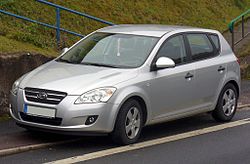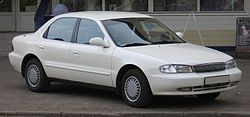Third generation (TF; 2011)
A completely redesigned Optima, named the
Kia K5 in the South Korean market, made its world debut at the 2010
New York Auto Show. It features a much sleeker, sportier profile designed by new Kia design chief
Peter Schreyer, following the new design language featured on the
Kia Forte,
Kia Sorento, and upcoming
Kia Sportage and
Kia Cadenza — and using Kia's new corporate grille, known as the
Tiger Nose, also designed by Schreyer. Lead designer of the TF in the team of Peter Schreyer and Miklos Kovacs was the Italian Davide Limongelli.
As with its
Hyundai Sonata sibling, the Optima's lineup has been replaced with a universal GDI 2.4 liter 4-cylinder engine, either mated to a 6-speed automatic transmission with Eco dash display, or to a 6-speed manual transmission that is only standard on the LX model. Sales are slated to begin in Fall 2010. The new K5 was released in the South Korean market on April 29, 2010.
The new Optima retains its trim lines of the base LX, upscale EX, and sporty SX models. Standard equipment include a slew of advanced safety features such as
ESC and
ABS brakes, as well as Sirius Satellite Radio, cooled glove box,
iPod connectivity, and handsfree
Bluetooth phone operation. EX models receive Kia's new
UVO infotainment system by
Microsoft with integrated backup camera, and
Proximity Key with Push-Button Start. SX models add a rear spoiler, metal pedals, black hybrid metal and carbon insert trim, paddle shifters, and illuminated scuff plates. A panoramic moonroof, heated front and rear seats, cooled front seats, heated steering wheel, and navigation system is also available.
A Hybrid model and Turbo model has been announced, and is predicted to arrive in early 2011. In addition, a wagon version will hit European markets, and two-door coupe version may arrive in the U.S. at a later date.
[9] The turbo model will have the same powertrain as the Hyundai Sonata 2.0T. The turbocharged model will have 274 hp (204 kW) and 269 lb·ft (365 N·m) of torque in the North American model.
[10] The car is estimated to obtain 34 mpg
-US (6.9 L/100 km; 41 mpg
-imp) on the highway.
[11]
[ Engines
| Model | Engine type | Power, torque@rpm | Note |
| Petrol engines |
| 2.0 MPI | 1,998 cc (121.9 cu in) I4 Theta II | 165 PS (121 kW; 163 hp), 20.2 kg·m (198 N·m; 146 ft·lbf) | Europe |
| 2.4 MPI | 2,359 cc (144.0 cu in) I4 Theta II | 180 PS (132 kW; 178 hp), 20.2 kg·m (198 N·m; 146 ft·lbf) | Europe |
| 2.0L Turbo | 1,998 cc (121.9 cu in) I4 turbo Theta II | 274 hp (204 kW; 278 PS)@6000, 269 lbf·ft (365 N·m)@1750 | North America |
| 2.4L | 2,359 cc (144.0 cu in) I4 Theta II | 200 hp (149 kW; 203 PS)@6300, 186 lbf·ft (252 N·m)@1750 | North America |
Source:
[12][11]
[ Hybrid version
The 2011 Kia Optima Hybrid was unveiled at the 2010
Los Angeles Auto Show, and will be launched in the market in 2011. The Optima Hybrid uses the
Hyundai Sonata Hybrid powertrain, combining a 2.4-liter engine with a six-speed automatic transmission, and a 30
kW electric motor and lightweight
lithium polymer batteries to produce a full
gasoline-electric hybrid with an estimated 37 miles per US gallon (6.4 L/100 km; 44 mpg
-imp) city and 39 miles per US gallon (6.0 L/100 km; 47 mpg
-imp) highway.
[13]















